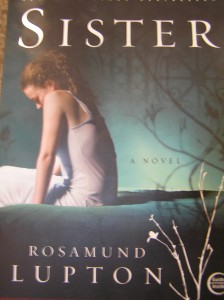The Blog
Sister–A Novel of Masterful Complexity
 Good stories have good layers. At least that’s been my experience in my too-many-to-mention years of reading and writing. So you can imagine my delight in reading Sister by Rosamund Lupton, a novel that’s layered in every way. On the first level, it’s a creepy, frightening mystery. Beatrice Hemming, a corporate designer in New York, flies home to London when she learns her younger sister, Tess, is missing. To find out about her sister’s lifestyle and any clues it might offer about her whereabouts, Beatrice moves into her apartment and begins to search for her friends and hangouts. As bits and pieces turn up, Beatrice makes startling discoveries about Tess, including the father of the child she was carrying, a cystic fibrosis study for curing fetuses she participated in, and a friend who loved her to the point of obsession.
Good stories have good layers. At least that’s been my experience in my too-many-to-mention years of reading and writing. So you can imagine my delight in reading Sister by Rosamund Lupton, a novel that’s layered in every way. On the first level, it’s a creepy, frightening mystery. Beatrice Hemming, a corporate designer in New York, flies home to London when she learns her younger sister, Tess, is missing. To find out about her sister’s lifestyle and any clues it might offer about her whereabouts, Beatrice moves into her apartment and begins to search for her friends and hangouts. As bits and pieces turn up, Beatrice makes startling discoveries about Tess, including the father of the child she was carrying, a cystic fibrosis study for curing fetuses she participated in, and a friend who loved her to the point of obsession.
As the mystery of Tess’s disappearance unfolds, Lupton skillfully explores Beatrice’s relationships with her family, giving another layer to the story. For Tess, Beatrice has always played the big sister role, the sensible sibling trying to reel in the exuberant artist. She would’ve played big sister for their brother, Leo, as well, if he had lived long enough, but he died from cystic fibrosis when he was a child. The stress of Leo’s death caused Beatrice’s father to leave the family, pushing Beatrice to think she needs to take care of her mother, too.
Digging into Tess’s life forces Beatrice to dig into her own life. What she finds there gives the story a third level. She’s always thought she was the caregiver to the family, but has that truly been the case? And what has sticking to the cautious, reasonable path done to her?
In addition to the levels of story that shape Sister, Lupton gives the reader sophisticated levels of storytelling. In the beginning, Beatrice as narrator is writing a letter to Tess, recalling highlights of their lives together and telling her what’s happened since she disappeared. A short way into the letter, however, she introduces Mr. Wright, a lawyer at the Crown Prosecution Service who is taking a statement from her. Then the letter becomes not only what she is telling Tess directly, but also what she is telling Tess about what she told Mr. Wright. It sounds complicated, but it’s done so well it’s easy to follow, and, as Lupton explains in an interview with the publisher, she had sound reasons for writing the book that way.
So, there is much in Sister to appeal to lovers of a good story (readers) and to lovers of good story craft (writers). Together, the various facets of the novel shape a literary masterpiece, complete with a conclusion that appropriately surprises and perplexes.
Tags: Books, reading
Get in Touch
Follow on Facebook
Follow on Twitter
___________________________________________________
Website Design by Eliza Whitney
 Posts from Late Last Night Books
Posts from Late Last Night Books




3 Comments
So glad that you enjoyed it. I did too!
Sister might not be my cup of tea, but what I did love was the way you reviewed the book, and then I re-acquainted myself with your artful blog. I’ll be back.
Judith
Thanks, Judith. I hope you’ll continue to stop by. I’m reading State of Wonder by Ann Patchett right now and plan to review it soon. Maybe it will be more your cup of tea.